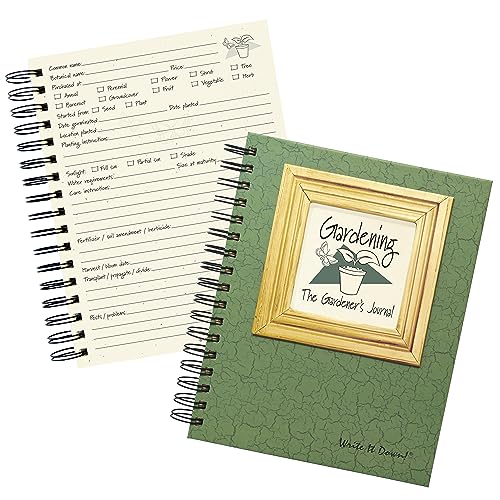Transform your gardening experience from hit-or-miss attempts to consistent success with a well-crafted garden journal. We’ve discovered that the difference between gardeners who struggle year after year and those who cultivate thriving gardens lies in one simple practice: keeping detailed records of what works and what doesn’t.
Your garden journal becomes your personal roadmap to gardening mastery. It’s where we track everything from planting dates and weather patterns to pest problems and harvest yields. This invaluable resource helps us make informed decisions about crop rotation fertilization schedules and variety selection.
Whether you’re a beginner looking to establish good habits or an experienced gardener wanting to optimize your results we’ll share creative journal ideas that’ll revolutionize how you approach your garden. From simple notebook layouts to digital tracking systems these strategies will help you create a personalized guide that grows more valuable with each passing season.
Start With Basic Garden Planning Layouts
Now that we’ve established the foundation for our garden journal, we’ll jump into the essential planning layouts that transform scattered gardening thoughts into organized action plans.
Monthly Planting Calendar Templates
Monthly planting calendars serve as our garden’s master schedule, helping us time every seeding and transplanting activity perfectly. We create a simple grid format with columns for crop names, indoor seeding dates, transplant dates, and direct sowing windows. Each month gets its own dedicated page where we record optimal planting times based on our exact climate zone and last frost dates.
| Month | Indoor Seeds | Direct Sow | Transplant |
|---|---|---|---|
| March | Tomatoes, Peppers | Peas, Spinach | Cool season crops |
| April | Herbs, Squash | Carrots, Radishes | Brassicas |
| May | Beans, Cucumbers | Corn, Sunflowers | Warm season starts |
Color coding different crop families makes our calendar visually intuitive and prevents planting mistakes. We use green for leafy vegetables like lettuce and kale, red for fruiting crops such as tomatoes and peppers, and yellow for root vegetables including carrots and beets. This system allows us to spot planting patterns quickly and ensures we’re maximizing our growing seasons effectively.
Seasonal Garden Maps and Diagrams
Seasonal garden maps provide us with a bird’s eye view of our entire growing space throughout the year. We sketch our garden beds to scale on graph paper, marking permanent features like trellises, water sources, and pathways that remain constant across seasons. Each season receives its own map showing exactly which crops occupy exact locations during spring, summer, fall, and winter growing periods.
Spring maps focus on cool weather crops like broccoli and lettuce that thrive in mild temperatures. Summer layouts showcase heat loving plants such as tomatoes, peppers, and squash that need full sun exposure. Fall diagrams highlight succession planting opportunities where we can grow second crops like radishes and spinach after summer harvests end.
We include sun exposure notes directly on our maps, marking full sun areas with bright yellow circles and partial shade spots with lighter symbols. Wind patterns get documented with arrows showing prevailing directions that affect plant placement decisions. Microclimates within our garden receive special attention, noting warmer south facing slopes and cooler north side areas that influence our crop selections.
Crop Rotation Planning Pages
Crop rotation planning pages help us maintain soil health while preventing pest and disease buildup in our garden beds. We divide our crops into four main families: nightshades including tomatoes and peppers, brassicas such as cabbage and broccoli, legumes like beans and peas, and root vegetables including carrots and onions. Each family gets assigned to exact beds on a rotating schedule that moves clockwise through our garden annually.
Our rotation charts track where each crop family grew in previous years and where they’ll move next season. We record soil amendments added to each bed, noting compost applications, organic fertilizers, and cover crops that restored nutrients between growing seasons. Heavy feeders like corn and squash get scheduled to follow nitrogen fixing legumes that naturally enrich the soil.
Disease pressure tracking becomes crucial in our rotation records, documenting any fungal issues or pest problems that affected exact beds. We avoid planting related crops in the same location for at least three years, giving soil time to recover and breaking pest life cycles. This systematic approach maintains our garden’s long term productivity while reducing our reliance on external inputs and treatments.
Track Your Planting and Harvest Records

Detailed planting and harvest records form the backbone of successful garden planning. These records transform random gardening activities into data-driven decisions that boost our yields year after year.
Seed Starting Documentation
Seed starting logs capture every detail from the moment we sow our first seeds indoors. We’ll record when each variety is sown, noting the exact date alongside the seed packet information including variety names and exact sowing instructions.
Growth stage observations help us identify patterns in our seedling development. Document germination rates, first true leaf emergence, and any unusual growth characteristics that affect transplant timing.
Seed packet storage within our journal preserves crucial variety information for future reference. Tape or staple empty seed packets directly onto journal pages, creating a permanent record of what we’ve grown and how it performed.
Environmental conditions during seed starting deserve careful attention. Record indoor temperatures, humidity levels, and lighting conditions that produced our strongest seedlings for replication next season.
Transplanting Timeline Entries
Transplant dates mark the critical transition from protected indoor growing to outdoor garden conditions. We’ll note both the planned and actual transplant dates, along with reasons for any schedule changes due to weather or plant readiness.
Post transplant care documentation tracks the immediate weeks following outdoor planting. Record watering schedules, mulching applications, and any protective measures like row covers or stakes used during the establishment period.
Survival rates give us valuable feedback on our transplanting success. Count how many seedlings successfully establish versus those that struggle or fail, helping us refine our hardening off process.
Weather impact during transplanting affects plant establishment significantly. Note temperature swings, unexpected frosts, or heavy rains that influence transplant survival and adjust future timing accordingly.
Harvest Yield Measurements
Harvest dates establish our personal growing calendar for each crop variety. Record when first harvests begin and when production peaks, creating a timeline that guides next year’s succession planting schedule.
Yield quantity measurements provide concrete data on garden productivity. We’ll track pounds harvested, number of fruits picked, or bunches gathered for each variety, revealing which crops deliver the best return on garden space.
Crop performance evaluations compare different varieties grown under similar conditions. Rate disease resistance, flavor quality, and overall satisfaction to identify winners worth growing again and varieties to skip next season.
Storage and preservation notes extend harvest documentation beyond picking day. Record which crops store well, preservation methods that work best, and estimated quantities preserved for winter consumption planning.
Monitor Weather and Environmental Conditions
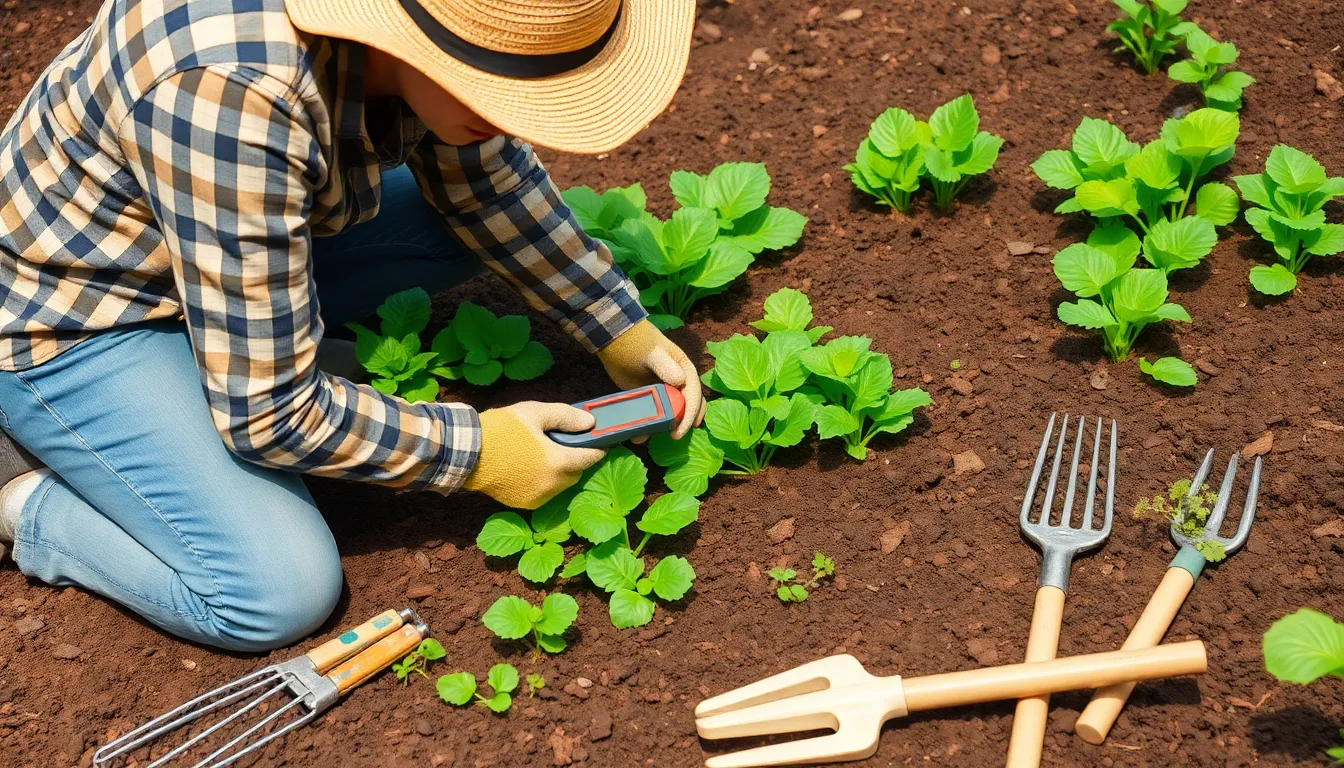
Weather patterns and environmental factors directly impact our garden’s success, making detailed monitoring essential for optimal growing conditions. Recording these variables helps us make informed decisions about planting, watering, and protecting our crops throughout the growing season.
Daily Temperature and Rainfall Logs
Temperature and rainfall tracking provides the foundation for successful garden planning and crop management. We recommend creating simple charts to record daily highs and lows alongside precipitation amounts, noting any extreme weather events that might affect plant growth.
Recording these measurements helps us identify patterns that influence planting schedules and harvest timing. Morning temperature readings give us the most accurate baseline data, while evening rainfall measurements capture the day’s total precipitation. Digital thermometers with memory functions make this process easier, though simple outdoor thermometers work perfectly well.
Weather data collection becomes invaluable when planning next year’s garden activities. Comparing temperature trends from previous seasons helps us predict optimal sowing dates and transplant windows. Rainfall records also guide our irrigation decisions, showing us when natural precipitation meets plant needs versus when supplemental watering becomes necessary.
Frost Date Tracking Systems
Frost dates determine our entire growing season timeline, making accurate tracking crucial for garden success. We document both the first and last frost dates each year, creating a historical record that helps predict future frost patterns and plan planting schedules more effectively.
Spring frost tracking begins in late winter when we start monitoring overnight temperatures. Recording the exact date of the last killing frost gives us confidence to plant tender crops outdoors. Fall frost documentation continues through autumn, noting when temperatures first drop below freezing and damage sensitive plants.
Microclimates within our gardens create varying frost patterns that standard weather reports don’t capture. Low-lying areas often experience frost earlier than raised beds or slopes, so we track these differences to maximize our growing windows. Protective measures like row covers or cold frames extend these seasons, and we document their effectiveness in our frost tracking systems.
Soil Condition Observations
Soil monitoring reveals the hidden foundation of garden health through regular assessments of moisture, pH, and nutrient levels. We check soil conditions weekly during active growing seasons, noting changes that might require adjustments to our gardening practices.
Moisture observations help us develop efficient watering schedules and identify drainage issues. Simple finger tests work well for basic moisture assessment, though soil moisture meters provide more precise readings. pH testing every few months reveals whether soil conditions support optimal nutrient uptake for different crop families.
Nutrient level documentation tracks the effectiveness of our fertilization and composting efforts. Visual observations of soil color, texture, and organic matter content provide valuable insights between formal soil tests. Earthworm activity, soil structure, and root development all indicate soil health improvements or concerns that affect plant performance throughout the growing season.
Document Plant Growth and Health Progress
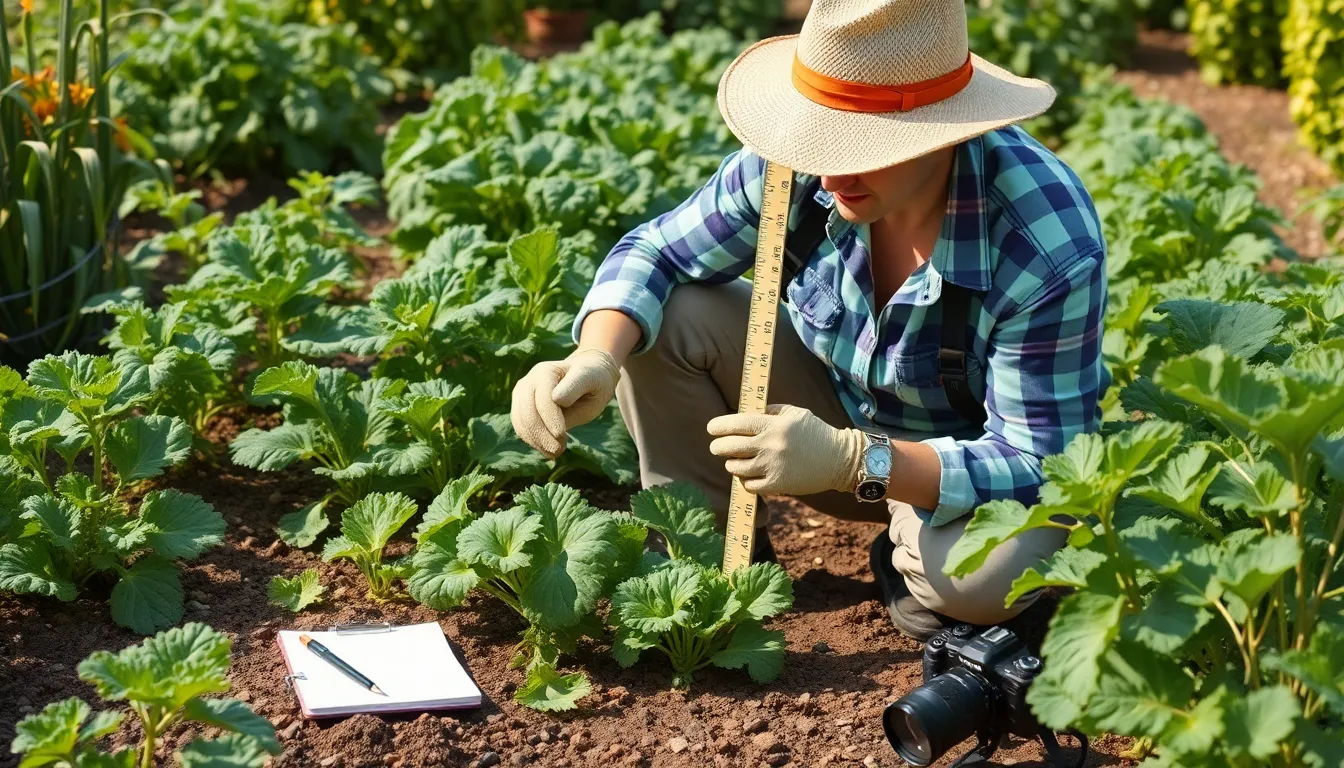
Capturing detailed observations about how our plants develop over time helps us understand what’s working in our garden and what needs adjustment. This systematic approach to documentation creates a valuable database of plant performance that guides future gardening decisions.
Weekly Growth Photo Collections
Weekly photography sessions create powerful visual records that reveal subtle changes we might miss during daily garden visits. We recommend taking photos from the same angle and distance each week to maintain consistency in our documentation.
Establishing a regular photo schedule helps us identify growth patterns and spot potential issues before they become serious problems. Digital cameras make it easy to organize these images by date and plant variety for quick reference throughout the growing season.
Including a ruler or measuring tape in our photos provides scale reference that quantifies actual growth progress. These visual measurements complement our written observations and create compelling before and after comparisons.
Creating photo folders for each plant variety streamlines our organization system and makes it simple to track individual plant performance. We can quickly compare how different varieties respond to identical growing conditions and care routines.
Disease and Pest Problem Records
Documenting disease symptoms and pest infestations as soon as they appear helps us develop effective treatment strategies for future seasons. We should record the date first noticed, weather conditions, affected plant parts, and any environmental factors that may have contributed to the problem.
Treatment effectiveness tracking requires detailed notes about which remedies we applied, application rates, and timing of treatments. This information becomes invaluable when similar issues arise in subsequent growing seasons.
Photography proves especially useful for disease identification since symptoms can change rapidly or disappear after treatment. Clear images help us consult gardening resources and extension services for accurate diagnosis and treatment recommendations.
Recovery progress documentation shows us which plants bounce back quickly and which struggle to overcome health challenges. These insights inform our plant selection decisions and help us create more resilient garden designs.
Fertilizing and Watering Schedules
Systematic fertilizer application records prevent both over and under feeding our plants throughout the growing season. We should note the fertilizer type, application rate, weather conditions, and plant response to each feeding session.
Watering frequency documentation helps us establish efficient irrigation schedules based on plant needs and weather patterns. Recording soil moisture levels before and after watering sessions reveals how quickly different areas of our garden dry out.
Creating simple charts or tables makes it easy to track multiple plants and their individual care requirements. These visual tools help us spot trends and adjust our maintenance routines based on actual plant performance data.
Seasonal watering adjustments become more precise when we have detailed records of past irrigation success and failures. Our documentation reveals which plants need more or less water during different growth stages and weather conditions.
Create Detailed Plant Profiles and Varieties
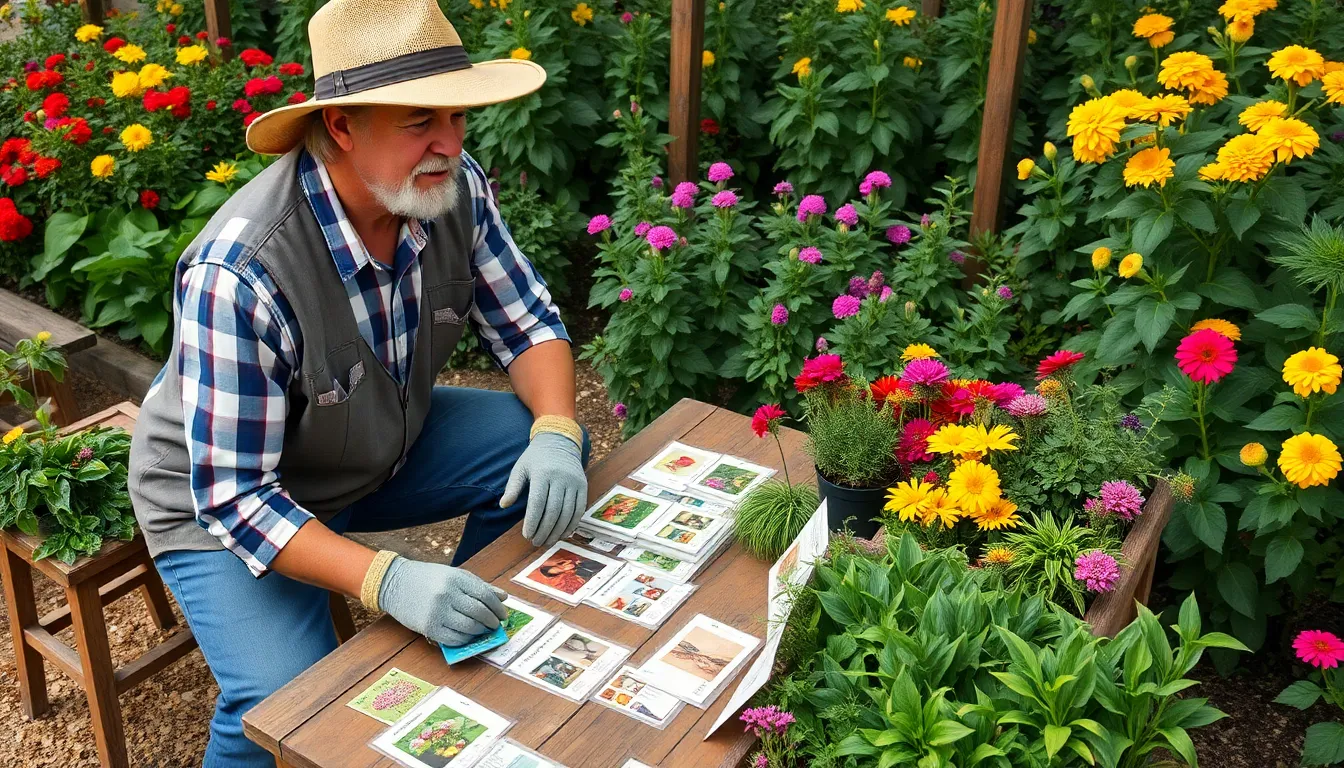
Building comprehensive plant profiles transforms scattered growing experiences into valuable gardening intelligence. We’ll establish systematic documentation that captures every detail from seed to harvest.
Seed Packet Information Storage
Create dedicated pages to preserve all seed packet details before they fade or get lost during busy planting seasons. We recommend designing templates that include seed type, variety name, company source, and purchase date for future reference[1].
Attach actual seed packets directly to journal pages using clear tape or photo corners to maintain quick access to original sowing instructions and maturity dates. This method prevents critical planting information from disappearing when packets get wet or torn.
Document germination rates by recording the number of seeds planted versus actual seedlings that emerged. We track this data to evaluate seed quality and determine whether to purchase from the same supplier next season.
Note expiration dates and storage conditions to maintain seed viability across multiple growing seasons. Seeds stored properly can often exceed their printed dates, making this tracking valuable for budget conscious gardeners.
Plant Performance Evaluations
Develop rating systems that evaluate plants based on growth rate, yield production, pest resistance, and overall garden performance using a 1 to 5 scale[5]. We create consistent criteria that allow meaningful comparisons between varieties and growing seasons.
Track blooming periods by documenting first flower dates, peak bloom times, and duration of flowering for ornamental plants. This information helps us plan succession plantings and design continuous color displays throughout the season.
Record pest and disease resistance by noting which varieties show natural immunity to common garden problems. We document exact issues encountered and how different cultivars responded to the same growing conditions[4].
Evaluate harvest yields by measuring actual production against expected results from seed packets or plant tags. We weigh harvests, count fruits, and assess quality to determine which varieties deliver the best return on our gardening investment.
Document care requirements including watering frequency, fertilizer needs, and maintenance demands for each plant variety. This helps us group plants with similar needs and allocate garden space more efficiently.
Variety Comparison Charts
Design comparison tables that display multiple varieties side by side with columns for key characteristics like maturity dates, size, flavor, and disease resistance[1][5]. We use these charts to make informed decisions about which cultivars to grow in limited garden space.
Include performance metrics such as days to harvest, average yield per plant, and success rate in our exact growing conditions. This data becomes increasingly valuable as we accumulate information over multiple seasons.
Rate adaptability to our local climate conditions by noting which varieties thrive in our soil type, rainfall patterns, and temperature ranges. We highlight winners and eliminate poor performers from future planting lists.
Compare flavor profiles for edible crops by documenting taste tests and family preferences. We note texture, sweetness levels, and cooking qualities to select varieties that match our culinary needs.
Track space efficiency by calculating yield per square foot for different varieties of the same crop. This information proves crucial for maximizing productivity in small gardens or raised beds.
Design Garden Layout Sketches and Maps
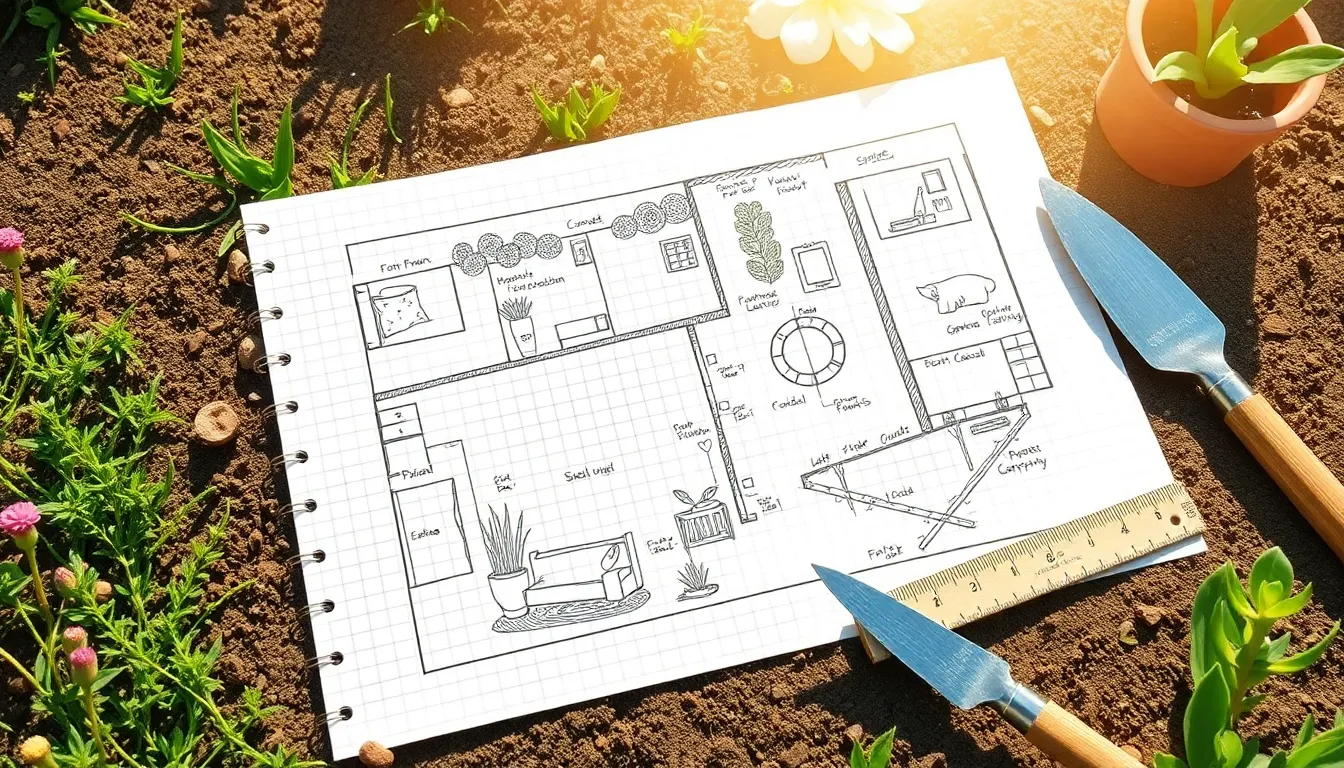
Creating visual representations of your garden space transforms scattered ideas into actionable blueprints that guide your growing success.
Plot Planning Drawings
Zone mapping becomes the foundation of efficient garden design when we divide our growing space based on sunlight exposure, soil conditions, and water access. Graph paper serves as our primary tool for sketching detailed garden layouts, allowing us to visualize different sections and features with precise measurements. We recommend creating scale drawings that include permanent structures like fences, trees, and water sources to establish reference points.
Plant placement records help us document the exact location of each variety, including notes on flowering times and mature plant sizes for future planning cycles. Detailed plot drawings should capture spacing requirements between plants, ensuring we maximize our growing area without overcrowding. We track the height and spread of each plant variety to prevent taller specimens from shading shorter ones unnecessarily.
Space allocation planning requires us to measure and mark our available growing area, then divide it into manageable sections based on crop families and maintenance needs. Each plot section needs clear boundaries and identification labels that correspond to our written records. We include pathways and access routes in our drawings to ensure we can reach all plants for care and harvesting.
Companion Planting Arrangements
Companion planting charts organize our knowledge of which plants thrive together, such as the classic pairing of marigolds with tomatoes for natural pest control. We create visual maps showing beneficial plant relationships, including nitrogen fixers like beans paired with heavy feeders like corn and squash. These charts help us plan crop groupings that improve soil health and reduce pest pressure naturally.
Strategic plant positioning involves placing compatible species within proximity while separating those that compete for resources or attract similar pests. We document successful companion combinations from each growing season, noting improvements in plant health and yield compared to solitary plantings. Our charts include timing considerations, ensuring companion plants have similar growing requirements and harvest schedules.
Natural pest management layouts show how we position trap crops and beneficial insect attractors throughout our garden space. We map the placement of herbs like basil and oregano that repel harmful insects while attracting pollinators to nearby vegetable crops. These arrangements create a balanced network that reduces our reliance on chemical interventions.
Future Garden Expansion Ideas
Growth tracking systems help us monitor which areas of our current garden produce the highest yields, informing decisions about where to expand next. We maintain detailed records of soil performance in different zones, noting which sections consistently support healthy plant growth. Our expansion plans include soil preparation timelines and infrastructure needs like irrigation and support structures.
Garden wish lists capture our dreams for future growing seasons, including new varieties we want to try and additional growing methods like raised beds or vertical systems. We research space requirements for desired plants, ensuring our expansion plans remain realistic and achievable within our available area. These lists include budget considerations and seasonal timing for implementing new garden features.
Infrastructure development plans outline the steps needed to support garden expansion, including pathways, water access, and storage answers for tools and harvested crops. We sketch potential layouts for greenhouses, cold frames, or season extension structures that could increase our growing capacity. Our expansion drawings consider long term maintenance requirements and accessibility as our gardening experience evolves.
Record Maintenance and Care Activities

Documentation of regular maintenance activities helps us stay ahead of garden needs and prevents small issues from becoming major problems.
Pruning and Trimming Schedules
Creating monthly pruning calendars keeps our plants healthy and productive throughout the growing season. We should list exact plants that need attention each month, noting optimal timing for different species based on their blooming cycles and growth patterns.
Spring pruning typically focuses on fruit trees and early flowering shrubs before buds break dormancy. Summer maintenance includes deadheading spent blooms and light shaping of fast growing plants. Fall trimming involves preparing perennials for winter and removing diseased or damaged branches.
Seasonal hedge and shrub schedules require different approaches depending on the species. Evergreen hedges respond best to trimming in late spring or early summer when new growth appears. Deciduous shrubs benefit from winter pruning when they’re dormant and structure becomes visible.
Tool Maintenance Reminders
The “Scrub, Sharpen, Sanitize” routine forms the foundation of proper tool care and extends equipment lifespan significantly. We should carry out this three step process after each major gardening session to prevent rust, disease spread, and performance degradation.
Monthly lubrication of moving parts prevents seizure and ensures smooth operation of pruners, loppers, and other mechanical tools. Storage in dry areas protects metal surfaces from moisture damage that leads to corrosion and premature wear.
Blade sharpening schedules depend on usage frequency but generally require attention every 4-6 weeks during active growing seasons. Sharp tools make cleaner cuts that heal faster and reduce plant stress compared to tears from dull equipment.
Garden Task Checklists
Seasonal task organization prevents us from missing critical timing windows that affect plant success. Spring activities include soil preparation, seed starting, and fertilizer application when plants begin active growth phases.
| Season | Primary Tasks | Secondary Tasks |
|---|---|---|
| Spring | Plant seeds, fertilize, prepare soil | Clean tools, check irrigation |
| Summer | Water regularly, monitor pests, prune | Harvest, deadhead, mulch |
| Fall | Clean debris, mulch, winter prep | Save seeds, plan next year |
| Winter | Prune dormant plants, plan garden | Order seeds, repair tools |
Daily maintenance includes watering checks, particularly during hot weather when soil moisture depletes rapidly. Weekly inspections for pest problems allow early intervention before infestations establish and spread throughout the garden.
Harvest timing records help us identify peak ripeness indicators for different crops. We should note visual cues, firmness tests, and taste characteristics that signal optimal picking times for future reference.
Capture Seasonal Garden Photography

Visual documentation transforms our garden journals from simple records into comprehensive storytelling tools. We’ll explore three essential photography techniques that capture our garden’s evolution throughout the seasons.
Before and After Transformation Photos
We create powerful progress records by photographing garden areas before starting any project and after completion. Taking these transformation shots from the same angle and distance helps us track successful strategies and identify what techniques work best in our exact growing conditions.
Document these key transformation moments:
- New bed preparation and final plantings
- Pruning projects and resulting growth patterns
- Infrastructure additions like trellises or raised beds
- Seasonal cleanup efforts and spring emergence
- Problem area improvements and recovery progress
We recommend taking photos at the same time of day to maintain consistent lighting conditions. Mark your photo locations in your journal sketches so you can return to the exact same spot for accurate comparisons.
Peak Bloom Documentation
We record when exact plants reach their peak bloom times to create a personalized flowering calendar for our gardens. This documentation helps us plan future plant combinations and ensures continuous color throughout the growing season.
Capture these peak moments:
- First bloom dates for perennials and annuals
- Full bloom displays at their most spectacular
- Bloom duration from start to finish
- Color intensity variations throughout the season
- Pollinator activity during peak flowering
We use this information to identify bloom gaps in our garden design and select new plants that fill those empty periods. Note the weather conditions during peak bloom times since temperature and rainfall significantly impact flowering schedules.
Problem Area Identification Images
We photograph struggling garden areas to identify patterns and develop targeted answers over time. These diagnostic images become invaluable references when consulting with extension agents or experienced gardeners about persistent problems.
Document these problematic situations:
- Pest damage progression and treatment results
- Disease symptoms from first appearance through recovery
- Soil drainage issues during wet and dry periods
- Sun exposure problems throughout the day
- Wind damage patterns and protective measure effectiveness
We take multiple photos of each problem area from different angles to capture the full scope of the issue. Include close up shots of exact symptoms alongside wider views that show the garden context where problems occur.
Include Inspirational Garden Quotes and Notes
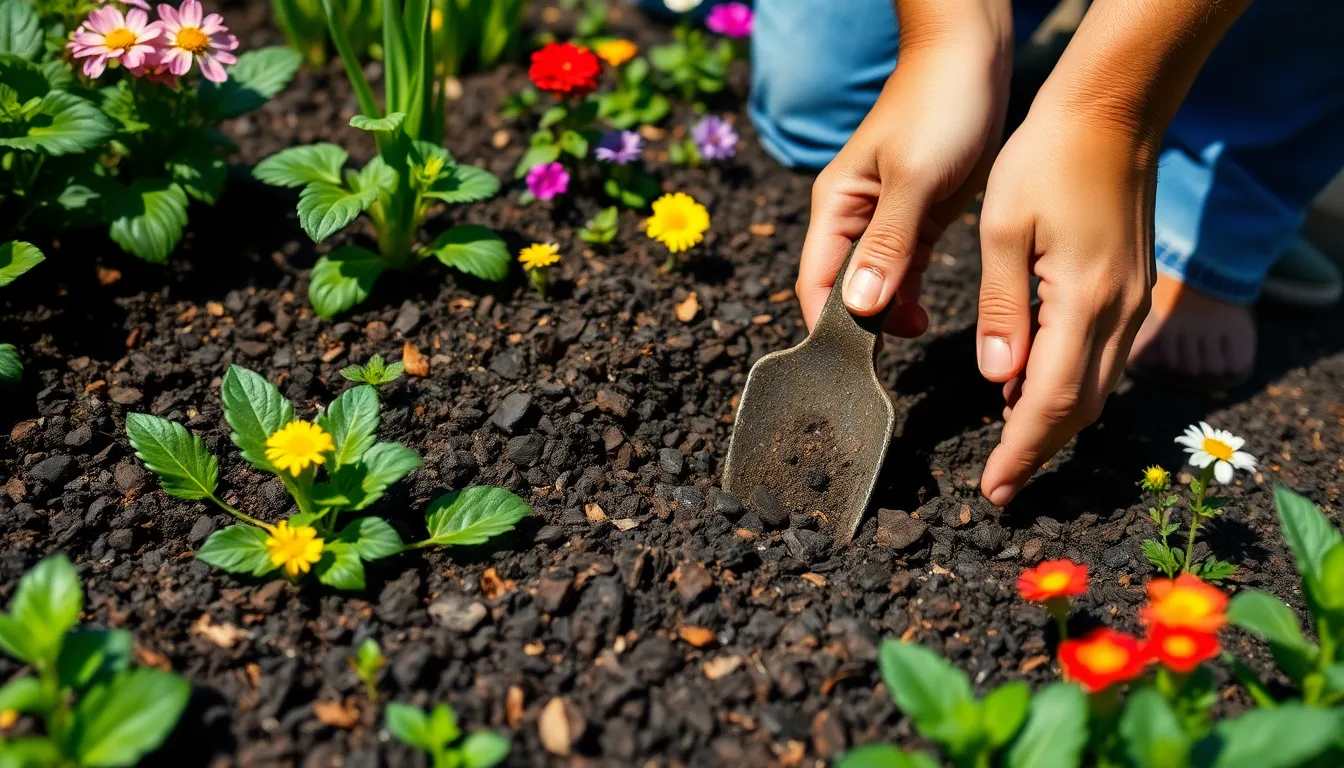
Words have the power to transform our gardening mindset and fuel our passion for nurturing plants. Recording meaningful quotes and wisdom creates a wellspring of motivation that we can tap into during challenging growing seasons.
Motivational Gardening Wisdom
Capture quotes that resonate deeply with your gardening philosophy. Jeff Cox’s words remind us that “The garden is a love song, a duet between a human being and Mother Nature,” perfectly expressing the intimate relationship we develop with our growing spaces. Write down meaningful passages from gardening books that speak to your experiences.
Create visual inspiration boards within your journal pages. Clipping images from gardening magazines keeps our creative energy flowing throughout dormant seasons. Add photos of dream garden designs or plant combinations that spark your imagination.
Document advice from experienced gardeners in your community. Local wisdom often proves more valuable than generic tips because it’s customized to your exact climate and growing conditions. Record conversations with master gardeners at workshops or farmer’s markets.
Set meaningful garden goals that align with your values. Whether you’re focusing on increasing biodiversity or improving soil health, writing down exact objectives transforms vague intentions into actionable plans. Track your progress toward these goals throughout each growing season.
Personal Reflection Entries
Record detailed observations about your garden’s daily changes. Weather patterns, plant growth stages, and wildlife activity create a comprehensive picture of your garden’s network. Note how morning frost affects tender plants or which flowers attract the most beneficial insects.
Document your emotional connection to gardening activities. Reflect on how working in the soil makes you feel and what lessons nature teaches you during quiet moments among your plants. These personal insights often reveal the deeper rewards of gardening beyond just harvest yields.
Track seasonal mood shifts and energy levels in your garden space. Many gardeners notice that their enthusiasm waxes and wanes with daylight hours and temperature changes. Understanding these patterns helps you plan activities when your motivation is naturally highest.
Write about challenges you face and how you overcome them. Pest infestations, unexpected weather events, or plant failures provide valuable learning opportunities when we take time to process and document our responses.
Lessons Learned Summaries
Create annual review pages that capture what worked exceptionally well. Successful plant varieties, effective pest control methods, and timing strategies deserve prominent documentation for future reference. List exact techniques that exceeded your expectations.
Document what didn’t work and analyze why failures occurred. Failed plantings often teach us more than successes when we examine contributing factors like timing, placement, or care methods. Record these insights to avoid repeating mistakes.
Summarize new techniques learned from workshops or online resources. Whether it’s a composting method or companion planting strategy, write down step by step instructions while the information is fresh in your memory. Include source information for future reference.
Track skill development and confidence growth over time. Note when you successfully tackle challenging tasks like grafting fruit trees or starting seeds indoors. These accomplishments build momentum for future gardening adventures.
Plan Future Garden Projects and Goals
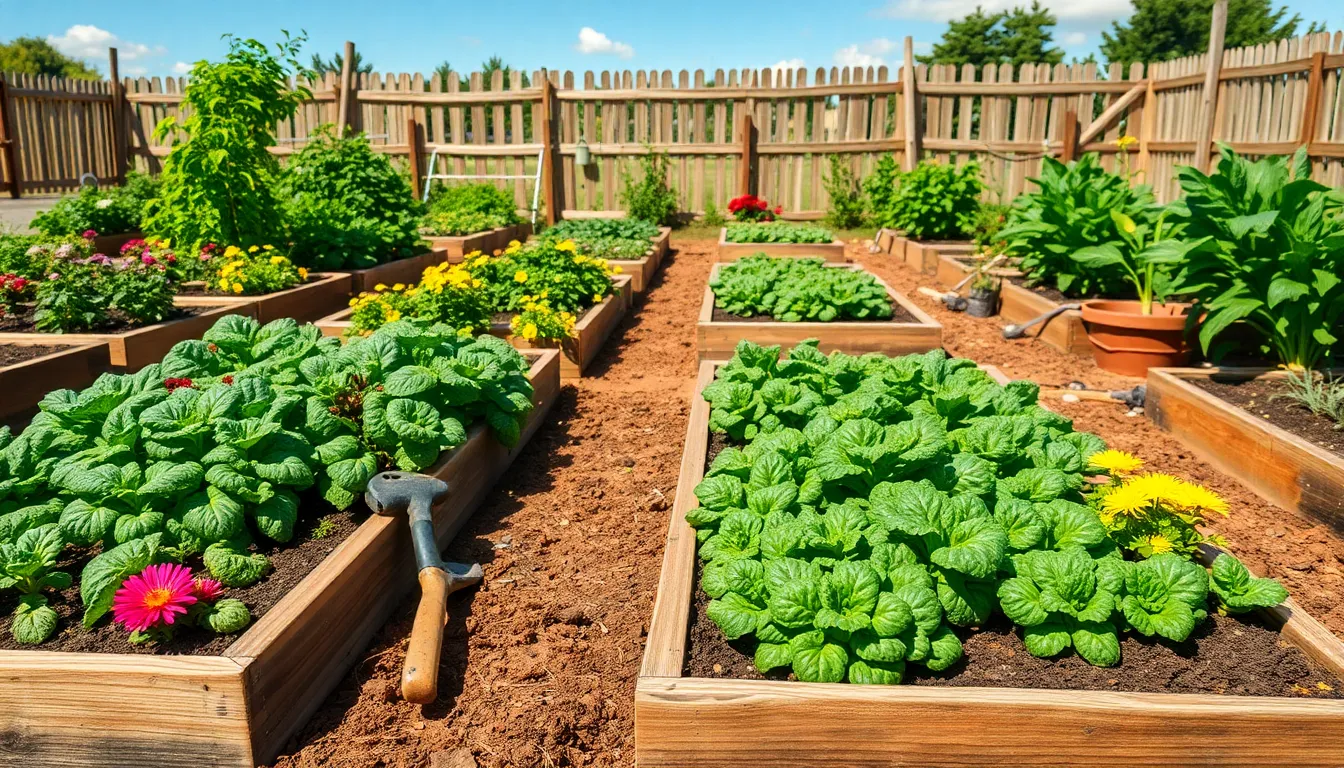
Creating a forward-thinking garden journal transforms our scattered dreams into achievable gardening objectives. These planning pages bridge the gap between current garden reality and future growing success.
Next Season Improvement Ideas
Problem-solving notes become our blueprint for overcoming recurring garden challenges. We document exact issues like pest infestations, poor soil drainage, or underwhelming harvests alongside potential answers researched throughout the growing season. Recording these challenges while they’re fresh helps us develop targeted strategies before the next planting cycle begins.
New plant selection requires systematic evaluation of varieties that might perform better in our exact growing conditions. We list promising alternatives to underperforming crops, noting their disease resistance, growth habits, and adaptation requirements. This proactive approach prevents us from repeating disappointing plant choices.
Garden expansion plans outline our vision for additional growing space or redesigned bed arrangements. We sketch potential modifications to existing layouts, considering factors like improved sun exposure, better water access, or more efficient use of available space.
New Variety Wish Lists
Seed and plant inventory tracking helps us maintain organized records of our current collection while identifying gaps in our garden diversity. We document the performance and yields of existing varieties, creating a foundation for informed purchasing decisions. This systematic approach prevents duplicate purchases and ensures we remember which varieties exceeded our expectations.
Research new varieties becomes an ongoing project where we compile detailed information about promising plants discovered through catalogs, gardening magazines, or fellow gardeners’ recommendations. We note their exact attributes, growth requirements, and compatibility with our climate zone to make educated selections for future seasons.
Long-term Garden Vision Boards
Visual planning transforms abstract garden dreams into concrete visual representations of our desired industry. We create boards featuring images of garden layouts, plant combinations, and structural elements like trellises or raised beds that inspire our long-term development goals. These visual references help us maintain focus on our ultimate garden vision.
Garden evolution tracking documents the transformation of our growing space over multiple years, creating a valuable record of what works and what doesn’t in our exact environment. We note successful plant combinations, infrastructure improvements, and seasonal challenges that shaped our garden’s development. This historical perspective guides future decision making and helps us recognize patterns in our gardening success.
Conclusion
We’ve explored how a well-maintained garden journal transforms scattered gardening efforts into organized success stories. These documentation strategies we’ve covered—from planting schedules to harvest records—create a personalized roadmap that grows more valuable with each season.
Your garden journal becomes your most trusted gardening companion once you start implementing these tracking methods. We’ve seen how combining visual documentation with detailed notes creates a comprehensive resource that guides better decision-making year after year.
The time you invest in journaling today pays dividends in future growing seasons. Whether you’re documenting pest patterns or planning crop rotations these records help you avoid repeating mistakes and maximize your garden’s potential.
Start with just one or two journal ideas that resonate with your gardening style. As your documentation habits develop you’ll naturally expand to include more detailed tracking methods that support your exact growing goals.
Frequently Asked Questions
What is a garden journal and why do I need one?
A garden journal is a detailed record of your gardening activities, including planting dates, weather patterns, pest issues, and harvest yields. It serves as your personalized roadmap to gardening success, helping you track what works and what doesn’t. The key difference between struggling and thriving gardeners is maintaining these detailed records to optimize future growing seasons.
What should I include in my monthly planting calendar?
Your monthly planting calendar should include seeding and transplanting schedules, using color coding to differentiate crop families. Document planned versus actual planting dates, weather conditions during planting, and any delays or adjustments. This master schedule helps you stay organized and ensures optimal timing for all your gardening activities throughout the growing season.
How do I track my harvest yields effectively?
Document harvest dates, quantities collected, and crop performance evaluations for each variety. Include storage methods used and quality assessments. Measure yields by weight, volume, or number of items harvested. This data helps you make informed decisions about which varieties to grow again and adjust planting quantities for future seasons.
Why is weather tracking important for my garden journal?
Weather tracking helps identify patterns that influence planting schedules and harvest timing. Log daily temperatures, rainfall amounts, and frost dates to determine your growing season timeline. This information helps you understand optimal growing conditions, develop efficient watering schedules, and make better decisions about when to plant and protect your crops.
How can I document plant health and growth progress?
Take weekly photographs from consistent angles and distances to create visual development records. Document disease symptoms, pest infestations, and treatment effectiveness promptly. Maintain systematic records of fertilizing and watering schedules to prevent over or underfeeding. These detailed observations help you understand what works and identify areas needing adjustment.
What’s the best way to compare different plant varieties?
Create detailed plant profiles with seed packet information, germination rates, and care requirements. Develop rating systems based on growth rate, yield, and pest resistance. Design comparison charts to evaluate varieties side by side, focusing on maturity dates, flavor profiles, and climate adaptability. This systematic approach maximizes productivity and informs future variety selections.
How do I create effective garden layout sketches?
Use graph paper for precise measurements and consider sunlight exposure, soil conditions, and water access. Include companion planting arrangements that improve soil health and reduce pest pressure. Document future expansion ideas and infrastructure development plans. These blueprints transform scattered ideas into actionable plans for growing success.
What maintenance records should I keep?
Document regular maintenance tasks with monthly pruning calendars tailored to specific plants. Track tool maintenance including cleaning, sharpening, and lubrication schedules. Create seasonal task checklists for critical activities like watering checks and pest monitoring. Record harvest timing indicators to refine picking practices for future crops and maintain plant health.
How can photography enhance my garden journal?
Capture before and after transformation photos to track progress over time. Document peak bloom times to create a personalized flowering calendar. Take diagnostic images of problem areas to analyze challenges and successes. Consistent photography of key moments and conditions enhances your understanding of garden evolution and supports informed decision-making.
What should I include in my future garden planning?
Document problem-solving notes for recurring challenges and evaluate new plant varieties for better performance. Outline expansion plans and maintain wish lists for new varieties. Create visual planning through garden vision boards and track plant performance over multiple seasons. This forward-thinking approach bridges current realities with future aspirations for continuous improvement.






